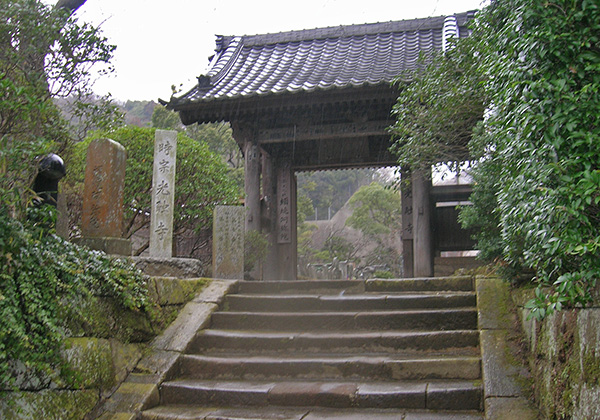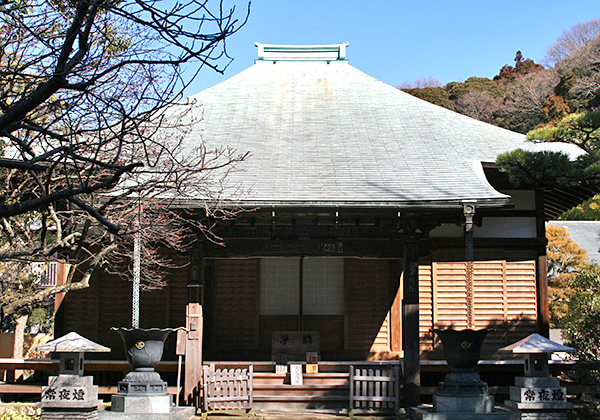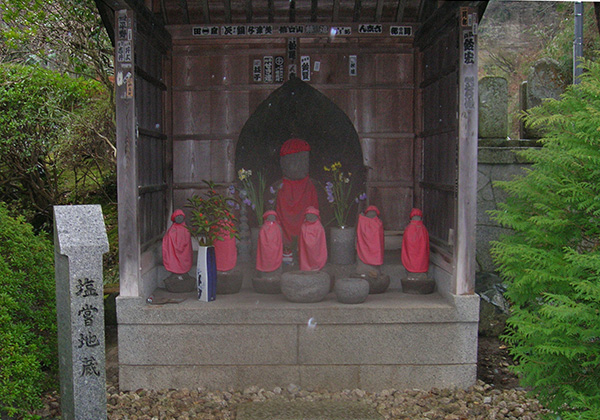Kosokuji
| Official Name | Ganzozan Kosokuji {pronounced gun-zoh-zan koh-sok-gee} |
|---|---|
| Religious sect | Ji {gee} sect |
| Founded | in 1279 by Chishin Ippen {che-shin (h)ip-pen} |
| Founding priest | Priest Sakua (?-1294) |
| Main object of worship | Statues of Amida {ah-me-dah} Trinity |
| Address | 793 Juniso, Kamakura, Kanagawa, 248-0001 (show route from current location ) |
| Location | 2,900 meters east of Kamakura Station |
| Time needed to get there | 40 minutes |
| Admission | Free |
| Open | 9:00 - 16:00 |
| Phone number | 0467-22-6864 |
| Restrooms | Available |
Historical Overview
The largest Ji sect temple in Kamakura, it was built by Priest Ippen (1239-1289), the founder of the sect. After learning at Enryakuji near Kyoto, he began his career as an mendicant priest of the Jodo sect at the very beginning, but developed his own doctrines later as a Buddhist of an independent sect. He preached commoners that chanting the sacred name of Amida or Nam-ahmy-dab-tsu repeatedly and dancing with this chant will bring them salvation immediately. Travelling all over the country, he gave them paper talismans inscribed with the sacred name of the Amida (Amitabha in Sanskrit) Buddha. Dancing with recitation of the holy Amida name throw them into ecstasy and his mission grew increasingly popular. In 1282, he and his followers tried to enter Kamakura, then the capital of Japan, for further spread of his doctrine, but was refused by Tokimune Hojo (1251-1284), the Eighth Regent and Zen Buddhism advocate. Rallying at the neighboring city of Fujisawa was, however, most successful and attracted many devotees. The mother temple of this sect, or Yugyoji {yoo-gyo-gee}, exists today in the middle of the city. (Yugyo means wayfaring priests or pilgrims.)
The Temple's legend narrates that there once lived a female attendant for Yoritomo Minamoto (1147-1199), the founder of Kamakura Shogunate, whose name was Machi-no-tsubone {mah-chee-noh-tsu-boh-neh}. She had Unkei {um-kay} (?-1223), one of the most notable Buddha-statue sculptor in the Kamakura Period (1185-1333) and often referred to as a Japanese Michelangelo, carve statues of Amida trinity in 1215, and enshrined them in her prayer hall. She worshipped them every day devoutly, but even more enthusiastic for worshiping them was her male servant called Manzai-hoshi {man-zye-hoh-she}. However, he had not always been behaving himself, and one day suspected of cheating or stealing something. Machi-no-tsubone burned his left cheek with a branding iron (a horseshoe) as a penalty. Even when he was being branded, he did not forget to chant "Nam-ahmy-dab-tsu" or a prayer to Amida. That night, Machino-tsubone had a dream in which the Lord Amida appeared with a clear brand on his left cheek and said "Why did you brand on my cheek?" Hearing this, she woke up and immediately summoned Manzai-hoshi only to find his brand had gone. Next, she went to the Amida Nyorai statue and found a brand on its left cheek. She ordered repairmen to fix the cheek of the statue. The repairmen tried to mend the cheek over and over again for 21 times, and yet the brand did not disappear. This was a clear indication to her that the Lord Amida bore the blame for Manzai-hoshi, a vicarious sacrifice, and she realized anew that the Lord Amida helps those who believe in him regardless of their behavior. It was a miracle and the news spread fast. Quite a few people began to visit her prayer hall to worship the statue of Amida. To accommodate those worshipers, she built a temple called Ganzoji {gan-zoh-gee} at Hikigayatsu {he-key-gah-yah-tsu} near Myohonji in 1217 as a Shingon sect temple, and enshrined there the said statues of Amida Nyorai trinity. Sixty-five years later in 1284, this Ganzoji was relocated to the present site together with the trinity statues and renamed the temple as Kosokuji converting the denomination to Ji sect same time. Unfortunately, no details are available as to the reason of the relocation and the conversion.

Statue of Ippen

Entering the gate, both sides of the path are already graveyards. Straight ahead is a bronze statue of Priest Ippen. Similar statues are found in many Ji-sect temples. As the founder of the Ji sect based on Pure Land Buddhism, he is known as a "wayfaring saint", which refers to his extensive travels for missionary work. Certainly, he was one of the most active and influential priests during the Kamakura Period.
Main Hall
Kosokuji
Official Name Ganzozan Kosokuji {pronounced gun-zoh-zan koh-sok-gee}
Religious sect Ji {gee} sect
Founded in 1279
by Chishin Ippen {che-shin (h)ip-pen}
Founding priest Priest Sakua (?-1294)
Main object of worship Statues of Amida {ah-me-dah} Trinity
Address 793 Juniso, Kamakura, Kanagawa, 248-0001
Area size 1,800 square meters
Location 2,900 meters east of Kamakura Station
Time needed to get there 40 minutes
Admission Free
Open 9:00-16:00
Phone number 0467-22-6864
Restrooms Available
Historical Overview
The largest Ji sect temple in Kamakura, it was built by Priest Ippen (1239-1289), the founder of the sect. After learning at Enryakuji near Kyoto, he began his career as an mendicant priest of the Jodo sect at the very beginning, but developed his own doctrines later as a Buddhist of an independent sect. He preached commoners that chanting the sacred name of Amida or Nam-ahmy-dab-tsu repeatedly and dancing with this chant will bring them salvation immediately. Travelling all over the country, he gave them paper talismans inscribed with the sacred name of the Amida (Amitabha in Sanskrit) Buddha. Dancing with recitation of the holy Amida name throw them into ecstasy and his mission grew increasingly popular. In 1282, he and his followers tried to enter Kamakura, then the capital of Japan, for further spread of his doctrine, but was refused by Tokimune Hojo (1251-1284), the Eighth Regent and Zen Buddhism advocate. Rallying at the neighboring city of Fujisawa was, however, most successful and attracted many devotees. The mother temple of this sect, or Yugyoji {yoo-gyo-gee}, exists today in the middle of the city. (Yugyo means wayfaring priests or pilgrims.)
The Temple's legend narrates that there once lived a female attendant for Yoritomo Minamoto (1147-1199), the founder of Kamakura Shogunate, whose name was Machi-no-tsubone {mah-chee-noh-tsu-boh-neh}. She had Unkei {um-kay} (?-1223), one of the most notable Buddha-statue sculptor in the Kamakura Period (1185-1333) and often referred to as a Japanese Michelangelo, carve statues of Amida trinity in 1215, and enshrined them in her prayer hall. She worshipped them every day devoutly, but even more enthusiastic for worshiping them was her male servant called Manzai-hoshi {man-zye-hoh-she}. However, he had not always been behaving himself, and one day suspected of cheating or stealing something. Machi-no-tsubone burned his left cheek with a branding iron (a horseshoe) as a penalty. Even when he was being branded, he did not forget to chant "Nam-ahmy-dab-tsu" or a prayer to Amida. That night, Machino-tsubone had a dream in which the Lord Amida appeared with a clear brand on his left cheek and said "Why did you brand on my cheek?" Hearing this, she woke up and immediately summoned Manzai-hoshi only to find his brand had gone. Next, she went to the Amida Nyorai statue and found a brand on its left cheek. She ordered repairmen to fix the cheek of the statue. The repairmen tried to mend the cheek over and over again for 21 times, and yet the brand did not disappear. This was a clear indication to her that the Lord Amida bore the blame for Manzai-hoshi, a vicarious sacrifice, and she realized anew that the Lord Amida helps those who believe in him regardless of their behavior. It was a miracle and the news spread fast. Quite a few people began to visit her prayer hall to worship the statue of Amida. To accommodate those worshipers, she built a temple called Ganzoji {gan-zoh-gee} at Hikigayatsu {he-key-gah-yah-tsu} near Myohonji in 1217 as a Shingon sect temple, and enshrined there the said statues of Amida Nyorai trinity. Sixty-five years later in 1284, this Ganzoji was relocated to the present site together with the trinity statues and renamed the temple as Kosokuji converting the denomination to Ji sect same time. Unfortunately, no details are available as to the reason of the relocation and the conversion.
Statue of Ippen
Entering the gate, both sides of the path are already graveyards. Straight ahead is a bronze statue of Priest Ippen. Similar statues are found in many Ji-sect temples. As the founder of the Ji sect based on Pure Land Buddhism, he is known as a "wayfaring saint", which refers to his extensive travels for missionary work. Certainly, he was one of the most active and influential priests during the Kamakura Period.
Main Hall
Turn left at the statue of Priest Ippen, and you will find the main hall. The present hall was rebuilt in 1859. Damaged by the Great Kanto Earthquake in 1923, it was repaired the next year. Chinese characters Kosokuji appearing on the plaque were brushed by Emperor Godaigo {go-dye-go} (1288-1339). Inside the hall is beautifully decorated. The main objects of worship are the statues of Amida Nyorai trinity, an Important Cultural Asset. The Nyorai statue in the center is called Hoho-yake {ho-ho-yah-kay} Amida or Branded-cheek Amida named after the episode above. It is 96.7 centimeters tall and is obviously under the influence of the Unkei school sculptors, though there is no evidence that it was really fashioned by Unkei. The gilded statue is now almost blackened.
Flanking on his left (to your right) is a 61-centimeter-tall statue of Sho Kan'non Bosatsu (Arya-avalokitesvara in Skt.), which is said to have been fashioned by Kaikei {kye-kay} (a disciple of Unkei's father. His birth and death year unknown). On his right (to your left) is the same size statue of Seishi Bosatsu (Mahasthama-prapta in Skt.), which was reportedly carved by Tankei {tan-kay} (1173-1256), son of Unkei. The Sho Kan'non here, meanwhile, ranks 7th in the Kamakura Thirty-Three Kan'non Pilgrimage.
Since there is no evidence to show that Unkei had ever come to Kamakura, the genuineness of the sculptors above are in doubt. But, experts on Buddhist sculptures all agree that they were made in the first half of the 13th century.
Unfortunately, those statues are not open to the public. For occasional visitors, it is necessary to form a group of 10 or more and make an appointment one week in advance. The fee is 200-yen per head.
The feretory was donated by Mochiuji Ashikaga {mo-che-woo-gee ah-she-kah-gah} (1398-1439), the Fourth Kamakura Governor. Though present one was rebuilt in the Edo Period (1603-1868), it still exhibits something like the "Ashikaga style", say connoisseurs.
The Temple also owns two rolls of painted handscroll, on which the episode of Machino-Tsubone and Manzai-hoshi are illustrated. Another ICAs, the scrolls alternate textual description written by Tamesuke Fujiwara {tah-meh-soo-keh foo-gee-wah-rah} (1263-1328), a famous Tanka poet during the Kamakura Period, and paintings drawn by a painter of the famous Tosa {toh-sah} school, a specialist group of the traditional Japanese paintings. They are kept at Kamakura Museum and on display from time to time.


